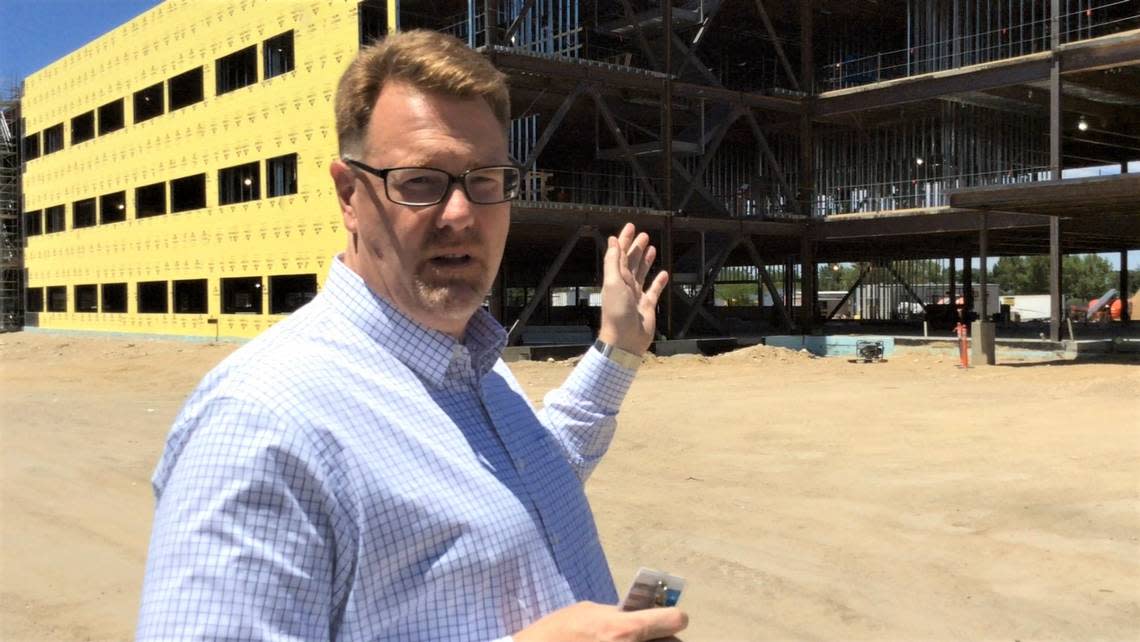Micron’s ‘mega fab’ planned for New York won’t be bigger than Boise’s plant. Yet
Micron Technology Inc. announced big plans to expand in New York state, but engineers at its headquarters in Boise will still lead the company’s technology development efforts.
The chip-making company announced Tuesday that it would invest $100 billion over the next two decades to build a “mega fab” for memory manufacturing in Clay, New York, about 15 miles north of Syracuse. Fab is short for semiconductor fabrication plant.
Construction on the massive site is expected to begin in 2024 with production ramping up in the years after.
Last month, Micron announced also plans for a $15 billion fab at its Southeast Boise campus.
The two investments follow passage of the CHIPS and Science Act, signed by President Joe Biden in August, which provided $52 billion in grants and subsidies to boost domestic manufacturing of semiconductor chips.
Along with the federal subsidies, Micron’s fab in New York will benefit from $5.5 billion in incentives from the state. The company also said it received infrastructure support from the city of Clay and Onondaga County.
Scott DeBoer, executive vice president of technology and products, told the Idaho Statesman by phone that he couldn’t comment further on what those incentives entail.
“Boise is the centerpiece of our technology development efforts,” DeBoer said. “The technology out of Boise will go to New York, it’ll also go to other places, it’ll go to Japan, it’ll go to Taiwan and to wherever we have manufacturing fabs already.”

Micron used to make chips in Boise, where the company was founded, but halted manufacturing operations in 2009 and ramped up production at other fabs, mainly abroad.
Its Boise site evolved into the company’s principal research-and-development center.
The chip technology is developed in Boise, with the chips manufactured at fabs elsewhere in the U.S., Japan, Taiwan and Singapore, and assembled and tested in China, Malaysia, Taiwan and Singapore, a spokesperson for the company said.
In its announcement Tuesday, Micron said the mega fab planned for New York will be the largest ever built in the history of the U.S. But less than a month ago, the company said the same thing about its fab planned for Boise.
‘The fab in Boise is going to be very big’
“When you’re talking all these huge numbers, it’s a little bit easy to lose sight of, but the fab in Boise is going to be very big,” DeBoer said. “It’s a big fab connected to the R&D lab.”
The New York fab will likely include four 600,000 square-foot clean rooms, according to the company’s news release. Clean rooms are spaces, controlled from contamination, where silicon wafers are turned into integrated circuits. The plant would occupy 2.4 million square feet, or the size of about 40 football fields.
Micron President and CEO Sanjay Mehrotra has said the Boise fab will be the size of about 10 football fields. The company held a groundbreaking ceremony at its Southeast Boise headquarters Sept. 12.
“It’ll be a long time before New York is actually bigger than Boise,” DeBoer said. “The plan is that if you look out 15 years, Boise will be big but New York will be bigger.”
DeBoer said the new fab in Boise will be dependent on the local workforce and the company’s relationship with community colleges and universities in the Northwest.
He also said the New York site has advantages including access to water, power, land, a large population and affordable housing. The location in Onondaga County was also selected for its proximity to higher education institutions in the region.
With the two fabs, Micron hopes to increase its U.S.-based manufacturing of DRAM, or dynamic random-access memory, to about 40% of its global production in the next decade.
“We think of this really as a partnership between these two fabs to ultimately combine to deliver our leading-edge DRAM technology,” DeBoer said.
The growth in sales of semiconductor chips is down worldwide, according to previous reporting by the Statesman. Last week, Micron reported a 20% decline in year over year sales. To reduce costs, the company is scaling back nearly half its capital investment in chip wafer-manufacturing equipment.
But DeBoer said he’s confident in the long-term demand and importance of memory products to a society that’s increasingly reliant upon artificial intelligence.
“There’s going to be some tougher market conditions like we’re dealing with now,” he said. “Overall, these things are growing, and we have to plan for the long-term demand cycle.”
Micron announces site for U.S. ‘megafab’ far larger than one it just unveiled for Boise
Exclusive: Micron CEO reveals new details about Boise plant, plans for housing workers
Micron stumbles, announces cost cuts as sales sag. The profit outlook? ‘Just awful’
